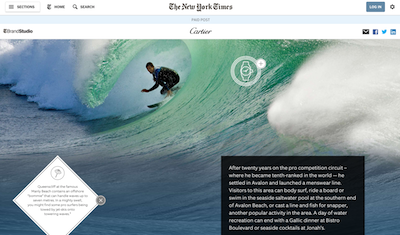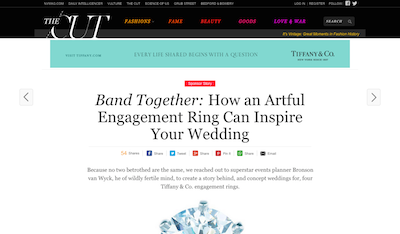luxurydaily.com
 As consumers tire of banner and pop-up advertisements, native advertising content has provided brands and publishers with less intrusive options to communicate their messages.
As consumers tire of banner and pop-up advertisements, native advertising content has provided brands and publishers with less intrusive options to communicate their messages.
Undoubtedly one of the buzziest terms of 2015, native ads saw a 28 percent year-over-year increase in 2015, with nearly 4,000 brands, and a monthly median of 504 new brands, opting to place this type of content. With the Fair Trade Commission’s new guidelines for native ads, announced in December 2015, marketers must be attuned to how to properly present native content as to not mislead or provide false information to consumers.
“Consumer behavior has shifted over the years, leading many to ignore display advertising,” said Todd Krizelman, CEO/co-founder of MediaRadar. “Think banner blindness. This has driven advertisers to look for new ways to reach audiences.
“Native has been popular with advertisers, but with many users too,” he said. “Native advertising, done well, is valuable content. What The Atlantic, Forbes, Buzzfeed and The New York Times provide is often extremely high quality editorial, even though it’s sponsored by the advertiser.
“Brands benefit the most from native ads. Unlike display ads, native ads weave brands directly into the editorial narrative. This brings a brand closer to the audience than ever before. They’re no longer separated to the right navigation space.”
MediaRadar, a multimedia sales enablement platform, prepared a white paper titled “The Impact of the FTC’s Guidelines for Native Ads.” In its paper, MediaRadar offers FTC compliance tips and insights into categories that have nailed native content.
Native awareness
When the FTC’s updated guidelines go into effect, MediaRadar estimates that 70 percent of sites will need to modify their approach to native advertising. While publishers such as Forbes, The Atlantic and Buzzfeed are pegged as frontrunners in the space, the lack of standard native advertising style will present challenges for the industry.
When the FTC’s updated guidelines go into effect, MediaRadar estimates that 70 percent of sites will need to modify their approach to native advertising. While publishers such as Forbes, The Atlantic and Buzzfeed are pegged as frontrunners in the space, the lack of standard native advertising style will present challenges for the industry.
MediaRadar uncovered nearly 40 different native advertising styles, some of which were clearly indicated and others that were difficult to tell if the content was organic or sponsored. It is the latter that the FTC wishes to protect consumers from, in fear of spreading false or misleading advertising.
As native advertising has developed, publishers have sought out innovative and avant-garde techniques to stay ahead of the curve, thus leaving room for consumers to be mislead by the same messaging.
Essentially, the FTC is asking publishers and brand partners to be more transparent with how native content in represented, making sure that if it’s “pay for play” it is shown clearly to consumers. In the thousands of examples MediaRadar reviewed, less than 5 percent of native ads included the word “ad.”
Others are presenting content in a way that aligns with the guidelines. The New York Times, for example, includes “This is a paid post” for its native ads and The Guardian swapped “Brought to you by” for “Paid content.”
Take for instance, French jewelry maison Cartier, who captured the adventurous spirit of its ideal male consumer through a paid post featured on The New York Times’ Web and mobile sites.
For its “Going the Distance” effort, Cartier worked with The New York Times’ commercial content operation T Brand Studio to develop a story that profiled the “active, adventurous” wearers of the Calibre de Cartier Carbon Diver timepiece (see story).
When phrasing is broken down further, native advertising in 2015 was commonly labeled as sponsored, with 54 percent of publishers doing so. Twelve percent offered no label at all and the same percentage used the word “promoted.” Percentages under 10 opted for phrases such as “presented by,” “provided by,” “brought to you by,” “partner content” and other variations.
With only about 30 percent of sites being compliant with the FTC’s new guidelines, MediaRadar has compiled tips suggesting how to best adapt to the new protocol. The FTC’s guidelines are not meant to be disruptive, but are intended to safeguard the consumer experience.
Firstly, a disclosure is needed to inform consumers if content was paid for or influenced by advertisers. Secondly, the disclosure must use precise language such as “paid” or “sponsored” advertisement, with the word “promoted” being avoided.
Also, the advertiser’s logo must be visible in all native advertising and its placement matters as well to reinforce that it is indeed paid for content. Likewise, an author’s name should be present and the native ad must be clearly separated from editorial content published by staff.
Ad buyers must also take into consideration if the promoted content unit features video or sound. These ads are more complex, often including a thumbnail preview and a full-size unit.
The FTC does not allow publishers to use “deceptive door openers” to drive clicks. Consumers should be well aware that content is promoted throughout the discovery and interaction phase, with the brand’s logo being visible long enough for the viewer to take notice.
To avoid misleading consumers, a disclosure is needed on both the thumbnail and full version of the ad. This is also true for pop-up advertising and audio ads.
Best in show
Native advertising has opened the door to interesting and dynamic opportunities for brands at a time when many ad units were seen as stagnant.
Native advertising has opened the door to interesting and dynamic opportunities for brands at a time when many ad units were seen as stagnant.
MediaRadar found that the apparel and accessories category has excelled at adapting native advertising techniques into their marketing efforts. Between the fourth quarter of 2014 and Q4 2015, the apparel and accessories category grew its number of native ads by 82 percent.
Other industry sectors are about 50 percent below apparel and accessories’ adoption rates. For instance, food, retail and travel hover around 33 percent and media and entertainment and technology fall to 19 and 14 percent, respectively.
“The apparel industry has been effective in part because their audiences tend to be younger,” Mr. Krizelman said. “Web sites such as Buzzfeed, which attract a younger audience, helped popularize native advertising from day one.
“There have been almost 400+ apparel, accessories, and beauty brands placing native ads on fashion Web sites in the past year,” he said.
U.S. beauty brand Estée Lauder, for example, relied on its brand ambassadors to bring consumers to its sponsored content.
Estée Lauder’s “Girls’ Night!” post on Vogue’s Web site contained three videos of Kendall Jenner and Joan Smalls, the faces of the brand, preparing for a night out. The enormous popularity of the pair and a sensible placement on Vogue will likely lead to increased awareness of and conversions for the beauty brand (see story).
Girls’ Night Out Series: Kendall & Joan Party Prep | Estée Lauder
“Estée Lauder was one of the earliest adopters of native advertising in the beauty market,” Mr. Krizelman said. “They were particularly successful because they were flexible.
“Estée Lauder was one of the earliest adopters of native advertising in the beauty market,” Mr. Krizelman said. “They were particularly successful because they were flexible.
“They tested dozens of implementations, revising and iterating their messaging and design quickly,” he said. “This was a good recipe for success.
“This willingness to test is essential, since there is so much learning still happening.”


No comments:
Post a Comment